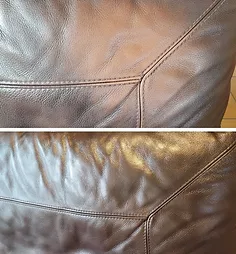
Why pigmented leather the colour fades away on your furniture?
Why Pigmented Leather’s Colour Fades Away: Causes and Prevention
Pigmented leather is a popular choice for many leather goods, from luxurious furniture and car interiors to fashionable accessories. This type of leather, characterized by its vibrant colour and durable finish, stands out due to its ability to resist stains and wear. However, despite its resilience, the colour of pigmented leather can fade over time. Understanding the reasons behind this fading and learning how to prevent it can help you maintain the allure of your leather items for many years. In this blog post, we’ll explore why pigmented leather loses its colour and offer practical tips to preserve its vibrant appearance.
What is Pigmented Leather?
Pigmented leather is treated with a coating of pigments and a protective finish, giving it a uniform colour and enhanced durability. Unlike aniline leather, which has a natural look and feel, pigmented leather is more resistant to stains, fading, and wear. The pigment layer not only adds colour but also serves as a protective barrier, making this type of leather ideal for high-traffic and high-use items. Despite these advantages, pigmented leather is not immune to colour fading, and several factors can contribute to this issue.
Common Causes of Colour Fading in Pigmented Leather
- UV Exposure: Prolonged exposure to ultraviolet (UV) rays from the sun is the primary cause of colour fading in pigmented leather. UV rays break down the pigments and protective coating, leading to a gradual loss of colour. This is particularly noticeable in furniture placed near windows and car interiors exposed to direct sunlight.
- Heat and Humidity: Extreme temperatures and fluctuating humidity levels can accelerate the fading process. Heat can cause the pigments to break down more quickly, while high humidity can weaken the protective coating, making the leather more susceptible to fading. This is why leather furniture and car seats in hot, humid climates often show signs of colour fading faster.
- Wear and Tear: Regular use, especially in high-contact areas like car seats, armrests, and cushions, can wear down the protective layer and expose the pigments to environmental elements, causing them to fade. The friction and pressure from daily use contribute to the gradual loss of the protective coating, leading to colour degradation.
- Improper Cleaning: Using harsh cleaning agents or methods not designed for leather can strip away the protective coating and damage the pigments, resulting in colour loss. Over-cleaning or scrubbing can also wear down the pigment layer. Many household cleaning products contain chemicals that are too harsh for leather, leading to accelerated fading and deterioration.
- Chemical Exposure: Spills from household products, body oils, and other chemicals can react with the pigments and protective coating, leading to discoloration and fading. Common substances like alcohol, oils, and even some cosmetics can cause the colour to break down and fade more quickly.
How to Prevent Colour Fading in Pigmented Leather
- Limit Sun Exposure: The most effective way to prevent UV-related fading is to keep your leather items away from direct sunlight. Use window shades, UV-protective films, or covers to protect furniture and car interiors from harmful UV rays. If complete avoidance is not possible, rotating the position of your furniture can help distribute exposure more evenly.
- Maintain Stable Conditions: Avoid placing leather items near heat sources or in areas with fluctuating temperatures and humidity. Use air conditioners, humidifiers, or dehumidifiers to create a stable environment for your leather. Keeping a consistent indoor climate helps maintain the integrity of both the pigments and the protective coating.
- Use Proper Cleaning Products: Clean your pigmented leather with products specifically designed for leather care. Avoid harsh chemicals and abrasive cleaners that can damage the protective coating and pigments. Regularly dusting and gently wiping down your leather items can help maintain their appearance without compromising the colour.
- Regular Conditioning: Conditioning your leather regularly with a high-quality leather conditioner helps maintain the protective layer and keeps the leather supple. This not only prevents the leather from drying out but also helps preserve the colour by maintaining the integrity of the protective coating. Conditioning should be part of a routine maintenance schedule, ideally every few months or as recommended by the product manufacturer.
- Immediate Spill Management: Quickly wipe up spills with a damp cloth to prevent chemical reactions that can cause discoloration. Use leather protectors to create a barrier against stains and spills. Having a leather cleaner and conditioner on hand can help you address spills promptly and effectively, reducing the risk of long-term damage.
- Routine Maintenance: Inspect your leather furniture regularly for signs of wear and tear. Address minor damages early to prevent further deterioration and fading. Professional leather repair services like Gold Coast Leather Cleaning and Repair can restore the protective coating and pigments if necessary
Conclusion

